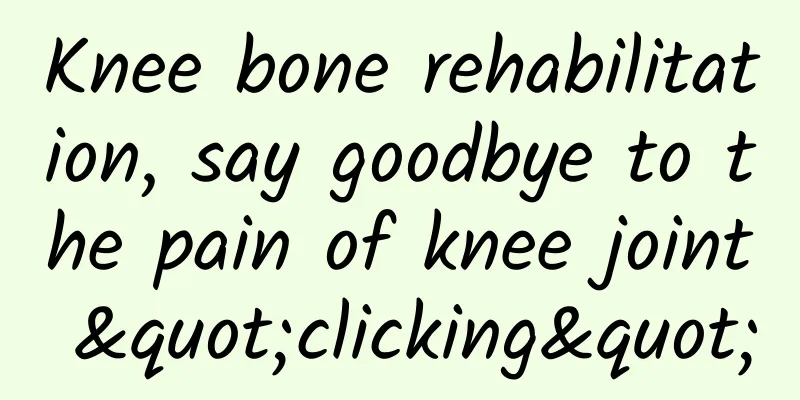Knee bone rehabilitation, say goodbye to the pain of knee joint "clicking"

|
Author: Yao Linming, deputy chief physician of the Fifth People's Hospital of Shaanxi Province Reviewer: Wang Xin, Chief Physician, Yan'an People's Hospital Knee osteoarthritis is a common joint degenerative disease that seriously affects people's daily lives. As the largest and most complex joint in the human body, the knee joint bears most of the body's weight, and its health is directly related to our freedom of movement. Figure 1 Copyright image, no permission to reprint 1. Symptoms of knee osteoarthritis The main symptoms of knee osteoarthritis include joint pain, joint swelling, and limited range of motion. These symptoms usually worsen after activity and improve with rest. 1. Joint pain: This is the most intuitive and common symptom of knee osteoarthritis. Patients often feel dull pain or tingling in or around the knee joint, especially when standing, walking, or going up and down stairs for a long time. The pain may gradually worsen and even affect sleep at night. 2. Joint swelling: Due to inflammation, swelling may occur around the knee joint. This swelling may also be accompanied by redness and heat in the skin around the joint, further exacerbating the patient's discomfort. 3. Limited movement: Patients with knee osteoarthritis often have limited movement, and as the disease progresses, the range of joint movement will further decrease. Patients may find it difficult to squat, stand up, or bend their knees. In severe cases, they may not even be able to complete these basic movements. This limited movement not only affects the patient's daily life, but may also lead to muscle atrophy and joint stiffness. Treatment of knee osteoarthritis There are many treatments for knee osteoarthritis, including medication, physical therapy, and surgery. The doctor will decide which method to choose based on the patient's condition. 1. Drug treatment: Drug treatment is usually the first choice for knee osteoarthritis. Nonsteroidal anti-inflammatory drugs, such as ibuprofen and celecoxib, can effectively reduce inflammation and pain and are commonly used therapeutic drugs. In addition, you can also consider using drugs that relieve muscle tension and improve joint movement, such as muscle relaxants or joint lubricants. However, it should be noted that some drugs, such as glucosamine and diacerein, need to be taken for a certain period of time before they can exert a stable therapeutic effect, so you must follow the doctor's advice and cannot stop taking the medicine at will. 2. Physical therapy: Physical therapy also plays an important role in the treatment of knee osteoarthritis. Physical therapy methods such as hot compress, cold compress, massage and physical therapy can improve blood circulation, relieve muscle tension, reduce joint pain and improve joint function. For example, hot compress can promote local blood circulation and accelerate the absorption of inflammatory substances; while cold compress can reduce local congestion and edema and relieve pain. In addition, massage and physical therapy by professional physical therapists can also enhance muscle strength and improve joint stability. 3. Surgical treatment: For patients with severe knee osteoarthritis who are not responsive to medication and physical therapy, knee replacement may be an effective solution. Knee replacement is a surgery that restores knee function by partially or completely removing the damaged knee joint and implanting an artificial knee joint. This surgery can significantly improve the patient's joint pain and limited mobility symptoms and improve the quality of life. However, it should be noted that surgery has certain risks and complications, and the indications and contraindications must be strictly followed. III. Rehabilitation strategies for knee osteoarthritis Rehabilitation is an integral part of knee osteoarthritis treatment. Through scientific rehabilitation strategies, patients can further consolidate the treatment effect and improve joint function and quality of life. 1. Scientific rehabilitation exercises: Through targeted exercises and training, such as knee extension, flexion and muscle strengthening exercises, muscle strength can be enhanced and joint flexibility and stability can be improved. These exercises should be performed under the guidance of a professional rehabilitation therapist or doctor to ensure safety and effectiveness. 2. Reasonable diet: Intake of foods rich in omega-3 fatty acids, such as deep-sea fish and flax seeds, can help reduce inflammatory responses; at the same time, high-sugar and high-fat foods should be avoided to control weight and reduce joint burden. Reasonable eating habits can help improve the patient's overall health and promote recovery. 3. Master the correct posture and skills: For example, when going up or down stairs, you should try to use the healthy leg to go up or down first; when standing up from a chair, you should first support your body with your arms, then stand up slowly, etc. These correct postures and skills can reduce the pressure on the knee joints, reduce the risk of joint injuries, and protect joint health. Figure 2 Copyright image, no permission to reprint In summary, the management of knee osteoarthritis is a comprehensive process, including drug therapy, physical therapy, surgical treatment and rehabilitation. Through scientific and reasonable treatment methods and rehabilitation strategies, most patients can say goodbye to the "clicking" pain of the knee joint, significantly improve their quality of life, and return to a normal life track. |
<<: Blocking AIDS and outperforming the golden "72 hours"
>>: Parents with these traits are more likely to raise children with bipolar disorder
Recommend
When an asthma attack occurs, why do people in movies and TV shows always use paper bags to breathe? Can this save lives?
If I tell you that this can really save lives, yo...
Is ductal carcinoma the same as breast cancer?
There are many types of breast cancer. So what is...
How should irregular vaginal bleeding be treated?
Irregular vaginal bleeding is a very common probl...
How to treat endocrine disorders in women
How to treat women's endocrine disorders is s...
Advantages and disadvantages of ultrasound at 37 weeks of pregnancy
We all know that it is very difficult for every p...
What is the cultural connotation of the Dragon Boat Festival? What are the special dishes of the Dragon Boat Festival?
The Dragon Boat Festival generally refers to the ...
When do black dates mature? Characteristics of black dates
I wonder if you have such doubts in your life, th...
The sweeter the fruit, the more sugar it contains! Some fruits are not sweet, but they are full of sugar!
In? Have you kept your sugar intake under control...
How to treat genital warts in women
Both men and women can suffer from genital warts,...
When walking, your knees suddenly become weak. Is there something wrong with your legs? Experts answer...
In daily life, many people may have experienced s...
Why can’t you do strenuous exercise during menstruation?
Many women know that there are many taboos to fol...









